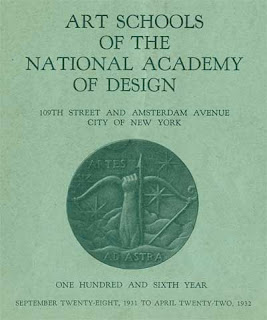
Excerpted from The ASIFA - Hollywood Animation Archive Blog by Steven Worth, Director
...the most common question I'm asked by young artists is, "How should I pick an animation school?" They always expect me to recommend a specific school, but my answer usually surprises them. Before I tell you the advice I give them, take a look at this past post...
Carlo Vinci: The Training Of A Golden Age Animator....This is the course outline for National Academy of Design, the art school that Carlo Vinci attended... I hope you take the time to read over this material carefully, especially if you are a student looking to pursue a career in animation. It will help you know what to look for in an animation school.
The Academy believes firmly in the development of individuality but denies that such development is helped by the ignoring of the universal heritage, the heritage of the graphic manifestations of Man's temperament and impressions. It therefore approves careful consideration of the Art of the past and its correlation with the Art of the present. It encourages progressive experiment admitting the vitality of real Art under any form and condemning only ignorance, insincerity and the contempt which is born of them. The class schedule runs six days a week from 9 in the morning until 4 in the afternoon. First year studios in drawing from sculpture, life drawing, portrait painting, still life painting, and composition run from two to three hours apiece. Second year courses consist of life drawing, sculpture from life, portrait painting, etching, composition, and mural decoration. And three hour night courses are offered in sculpture, life drawing, drawing from sculpture and composition.
First year students receive lectures in anatomy, perspective and art history. Second year students attend lecture classes in color theory, various printing techniques, stained glass, mosaic and the history of art and architecture.
Note that students first draw from still life and sculpture, and only when they have proved their abilities, are they allowed to advance to drawing from life.
How to Pick An Animation School?Here's the surprising answer... You don't! Schools that specialize in animation as a trade do a lousy job of preparing you for a career in animation. While you're a student, you should focus on your core art skills- drawing, design, composition and color. Look for a school that can give you a solid classical art background. Avoid ones that just teach computer programs. You don't have to spend thousands of dollars to learn Maya!
Carlo Vinci was one of the greatest animators who ever lived, but he never took a class in animation. Instead, he spent three years of intense study to learn to be an artist. With the experience he gained at the National Academy of Design, he was able to learn animation and advance quickly on the job. It was the same for great animators like Marc Davis, Chuck Jones and Frank Thomas who studied at Chouinard on the West coast. - Steven Worth
Link Full Text, Course Outline, Student Examples at The ASIFA - Hollywood Animation Archive Blog
Link The ASIFA - Hollywood Animation Archive Blog












